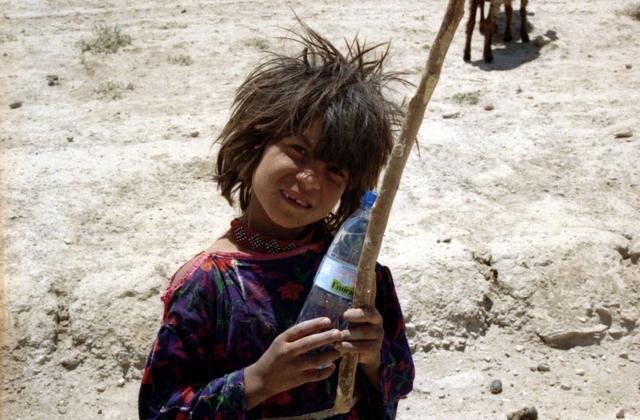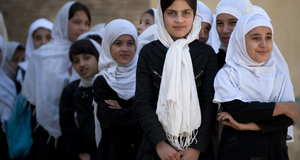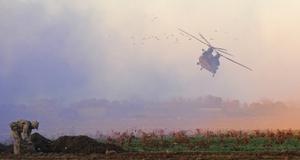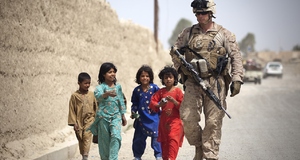From Cornell International Affairs Review VOL. 3 NO. 2Singing in the Wilderness: Kuchi Nomads in Modern Afghanistan
IN THIS ARTICLE
KEYWORDS
The word kuchi conjures up a romantic but ultimately anachronistic lifestyle—tattooed women in red and gold embroidered dresses and men riding alongside flocks of goat and sheep; the reality, however, differs starkly. The past two decades of armed conflict, poverty and socioeconomic change have had a profound impact on Afghanistan's kuchi nomads, and the United Nations Assistance Mission in Afghanistan (UNAMA) have identified them as one of the country's largest vulnerable populations.1 In contemporary academia, though, there has been a dearth of literature that links issues particularly salient to the kuchi—the pastoral economy, internal displacement, and their relations with the Afghan government as well as other societal groups—to Afghanistan's reconstruction and development. Modernity requires that the kuchi no longer be distinct and removed from the Afghan state. Kuchi participation and representation in government is the necessary first step for their issues to be effectively addressed; at the same time, cautious measures must be taken to preserve their culture and distinctive lifestyle. Who Are the Kuchi?Kuchi is an Afghan Persian word, literally translating as "those that go on migrations," from the Persian word "koch," or "migrations."2 Indeed, while this word has been used as a pejorative similar to the use of the word "gypsy" in the West, connotations vary across the nation. For example, there are citizens of Kabul from wealthy families that settled down from a nomadic lifestyle generations ago who still describe themselves as kuchi. As Paul Garwood noted in an article for the Associated Press on May 14, 2006, Hashmat Ghani Ahmadzai, the selfproclaimed (and oft discredited) leader of the kuchi, is vice-president of a American security firm and the heir of a land-owning family in the trucking business. Though he is the chief of an organization called the Grand Council of Kuchi, he in effect has little-to-no say over the wide-ranging nomads--he does not even have a seat among the ten seats guaranteed to the kuchi in the Afghan parliament. Kuchi can be most accurately described as a traditionally migratory lifestyle that depends on livestock for livelihood. Not all kuchi are fully migratory; however, many gradually shifted into a semi-nomadic lifestyle with permanent winter residences. The kuchi who have settled in the past decade to become sedentary farmers or urban laborers are still considered kuchi for the purposes of this paper; very often, if crops fail or livestock dies, they will revert to a nomadic lifestyle, wandering for better grazing lands or communal support.3 Some former kuchi, as mentioned before in the case of Hashmat Ghani, come from families who have been settled for generations. While they might consider themselves kuchi, their lifestyle, livelihood, and concerns are largely divorced from the majority of the kuchi; the vagaries and challenges of urban life, while legitimate, lie outside the scope of our paper. Ethnically, the vast majority of kuchi are Pashtun. The kuchi also count Baloch, Arab, as well as Tajik and Uzbek in the north, among their numbers.4 Today, there are no precise figures regarding the number of kuchis in Afghanistan; Afghanistan has not conducted a population census in twentyfive years, and counting kuchis is particularly difficult due to their nomadic lifestyle. Despite this, the National Multi-sectoral Assessment on Kuchi (NMAK), conducted by the Ministry of Rural Rehabilitation and Development in 2005, estimated the kuchi population at about 2.5 million, 1.5 million of which remain fully nomadic. Economic conditions, drought, the increasingly monitored borders between Iran, Afghanistan, and Pakistan, and the plague of landmines across their migratory routes have effectively made a fully nomadic lifestyle impossible for some, and difficult for others.5 The Life NomadicThe traditional kuchi lifestyle involves highly fluid units of approximately eleven households at a time, herding 450-600 sheep and/or goats (as well as, to a much more limited extent, cattle) along migratory paths.6 As winter turns to spring, vegetation sprouts in the highlands of central Afghanistan and the kuchi move inward to utilize the relatively rich grazing lands. Even agricultural fields, harvested by sedentary farmers, provide an abundant source of feed for a nomad's flock. At the end of summer, the kuchi will return to their lowland pastures along the border (and even across the Iranian and Pakistani borders), where the animals are often fed only enough to survive.7 During these spring and summer migrations, various households will leave and rejoin other herding units as they wish; no unit remains continuous while traveling, and only the number of livestock remains the same. Due to the variable nature of kuchi units, a wide variety of tribes often travel together and share rights to pastoral grazing lands.8 "Beyond even their own products, the nomads have played an important role in the spread of essential items, such as kerosene, tea, and matches to various villages that might not otherwise have access." Kuchis' interactions with the settled communities are usually limited to economic interactions—the trading of crafts and animal products for fruits, necessary crafting materials, and sometimes even water and grazing pastures. Kuchis produce and trade mostly milk from their livestock, due to its high nutritional value, although wool from sheep and cashmere from goats represent a large proportion of their goods and income as well.9 The women are responsible for most of the economic production as they are in charge of animal husbandry and the production of milk, wool, and cashmere while the men herd the flocks and represent the traveling unit when trading.10 Income from livestock products makes up the majority of a kuchi's income, but the kuchi often supplement this by assisting land-owning farmers with their summer harvests, or herding shoats for the farmers and other kuchi. Beyond even their own products, the nomads have played an important role in the spread of essential items, such as kerosene, tea, and matches to various villages that might not otherwise have access.11 With Bag and BaggageThe contribution of nomads to the Afghan economy can be easily overlooked, due to the seemingly archaic method of raising livestock. But the kuchi can afford to look after a greater number of livestock per capita than a settled farmer could, due to the migratory lifestyle's inherent lack of facilities. While productivity might be lower among iterant methods of raising livestock, it has been noted that the low margins and initial cost involved means that any investment in rebuilding a supply of livestock among nomads offers a more immediate alleviation of poverty.12 In addition, the kuchi occupy areas that are not easily made productive outside of livestock grazing. Although rangelands cover around 45 percent of the total land area in Afghanistan, between 70 and 85 percent of the total land area is effectively used for grazing because large areas are considered barren land. With increasing competition for landed resources and a trend towards intensification of agricultural production, marginal lands need to be put to optimal use. The necessity for making the most of Afghanistan's agricultural sector is clear: historically, livestock and livestock production have made a significant contribution to Afghanistan's GDP and exports. In prewar years, livestock and livestock products contributed 16 percent and 8-10 percent respectively to Afghanistan's GDP and livestock products made up about 35 percent of total exports.13 The intervening years, then, have dramatically stunted Afghanistan's development. During the drought that lasted from 1998 to 2002, the average number of sheep per nomadic household decreased from 21.9 to 2.9 and 60 percent of kuchi households lost all livestock in Registan.14 Considering the kuchi have been estimated to look after almost 50 percent of the nation's livestock, the loss takes on a drastic new toll.15 A Kuchi child holds a water bottle, something many of the remote villages of Afghanistan would not have access to otherwise. The Afghan government has begun to acknowledge the special needs of the kuchi population. According to an Afghanistan Research and Evaluation Unit report, the National Agricultural Development Framework (NADF)—a project approved by the parliament in December 2009—even differentiates between the various flavors of modern kuchi: "The Kuchi Support Program...distinguishes between Kuchis who continue to migrate and practice livestock-based livelihood system, and Kuchis who are semi-settled and practice a more diverse livelihood system. Of those who migrate, it also distinguishes between Kuchis who travel long distances across province boundaries, and those who travel short distances."16 The NADF, however, remains a conceptual framework for future programs rather than any tangible system in and of itself. Assuming there were even a specific and concrete implementation, the Afghan government still lacks the capacity to act in those provinces where many semi-nomadic kuchi reside. Of Lands and NeighborsAccess to PasturelandsEthnic tensions are closely linked with competition over land rights, complicated by a number of intersecting legal regimes, including constitutional law, state law, religious law, civil law and customary law. Currently, there is a lack of clear government policy on land tenure and pasture rights. Over the years, pasture has alternately been described either as community owned land or as government land. The Land Decree, issued in 2002 by President Karzai, effectively placed all pasturelands under government control, leaving no space for communally owned pasture.17 In rural areas, where the central government's presence is weak, customary law, rather than legal documents or the government's decree, holds weight. Historically, pasture users obtained access via different mechanisms: through pasture rights allocation by royal decree or through the provincial administration, through customary practice, and through payment of taxes to the ‘rightful' users. Since a single formal and mutually recognized system does not exist, the issue of access rights is an area of immense discontent.18 These days, the customary system of regulating access to pastures remains widespread and largely influenced by local power relations, despite the significant level of conflict surrounding access. User's rights are still, to an extent, established and recognized through customary systems; at the same time, they are subject to constant political maneuvering within local power relations.19 Greater clarity and enforcement regarding access to pasture land is quite obviously needed. Grievances Slow to FadeSerious challenges arise from the kuchi's poor relations with other groups, often of different ethnicities and lifestyles. The NMAK estimated that in 2003, 21 percent of kuchis could not access their traditional pasture area due to ethno-political conflicts.20 In the long-standing Kuchi-Hazara conflict, both groups place the blame squarely on the other. The settled Hazara population contend that they are facing predatory nomads, in cahoots with the Taliban, who want to take advantage of interethnic and sectarian tensions. Kuchi leaders argue that they are forcibly excluded from the pasturelands they have used for over a hundred years by Hazara aiming to create an Iranian-backed Shia ministate in the central highlands. More recently and widespread than the centuries old dispute over grazing lands, the Taliban initiated a major power shift in favor of the Pashtun kuchi. Nomad groups' access to major grazing lands increased with the support of these new rulers. The kuchi, most of whom are ethnically affiliated with the majority of the Taliban, were generally assumed to have provided support to the Taliban and indeed, many Taliban recruits did come from kuchi background. Whatever the actual degree of collaboration existed, the perceived alliance between kuchis and the Taliban have led to an increased resentment by the non-Pashtun groups that had suffered under the Taliban. Indeed, ethnic tensions are a significant security concern because of their potential to escalate quickly.21 DisplacementFor Afghanistan's growing internally displaced persons (IDP) population, there is a trend towards growing hardship and limited support. There are at least 200,000 IDPs in Afghanistan, 70 percent of which are kuchi.22 But because of the deteriorating security situation, access to IDPs remains limited. Additionally, NGOs have consistently argued that humanitarian space has shrunk in Afghanistan due to the blurring of the identities and functions of military and humanitarian agencies through the Provincial Reconstruction Teams (PRTs) duplicating NGO activites. As the identities and functions of military and humanitarian actors have become blurred, attacks on humanitarian groups have increased.23 In April 2004, the Afghan government announced an IDP National Plan to promote and accelerate the return and sustainable reintegration of IDPs to their villages of origin. The National Plan placed responsibility for the IDPs' reintegration, with support from specialized agencies such as UNHCR and International Organization for Migration. This plan has brought together the Ministries of Refugees and Repatriation (MoRR), Frontiers and Tribal Affairs (MFTA) and Rural Rehabilitation and Development (MRRD) and distinguishes four groups of IDPs: Pashtuns displaced from the northern provinces; kuchi IDPs displaced by drought from the Registan desert in the southern provinces of Kandahar, Helmand, and Nimroz; kuchi IDPs whose migratory routes encompass the pastoral lands in Ghazni, Uruzgan, and Bamyan; and drought-affected non-kuchis.24 According to the National Plan, IDPs should go back to their areas of origin where they will be allocated a plot of land. But conditions in the IDP settlements are arguably better than those in the areas of origin, with potable drinking water and limited access to education and health care. Most kuchis are unable to rebuild their herd and return to their traditional form of livelihood. In the absence of economic opportunity, it is a rational decision for them to remain in IDP camps as long as humanitarian aid is forthcoming. Unless present conditions change, the IDP camps are apt to become a self-perpetuating and enduring financial burden on the UN.25 Moreover, relief organizations and UN agencies dealing with IDPs have said that too much emphasis is placed on the initial stage of return and not enough on issues which may later arise.26Continued on Next Page » Suggested Reading from Inquiries Journal
Inquiries Journal provides undergraduate and graduate students around the world a platform for the wide dissemination of academic work over a range of core disciplines. Representing the work of students from hundreds of institutions around the globe, Inquiries Journal's large database of academic articles is completely free. Learn more | Blog | Submit Latest in Anthropology |




















